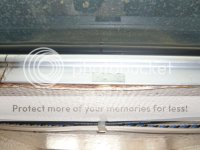Jake B
New member
- Joined
- Jun 6, 2012
- Messages
- 521
- Reaction score
- 0
- C Dory Year
- 1989
- C Dory Model
- 22 Cruiser
- Vessel Name
- PLUS 3
so spent about 4 hours pressure washing off 14 years of grime today on the boat. When I was done I went inside and seen that there was a few water spots on the cuddy cusions. wich confirmed what I thought and that was I had a leaking hatch door. I have checked it before after a rain and not seen any full penetration.
It seems to be worse on one side and the others don't seem so bad. so my question is has anyone dealt with a leak like this and what would be the best way to go about fixing it? I took one picture of the worse spot attached below. thanks for any help. I am hoping someone has done one of those step by step write ups i have seen on other fixes

It seems to be worse on one side and the others don't seem so bad. so my question is has anyone dealt with a leak like this and what would be the best way to go about fixing it? I took one picture of the worse spot attached below. thanks for any help. I am hoping someone has done one of those step by step write ups i have seen on other fixes

